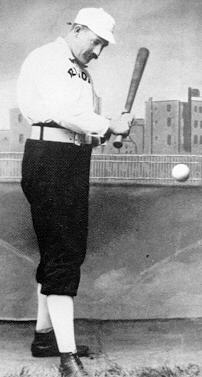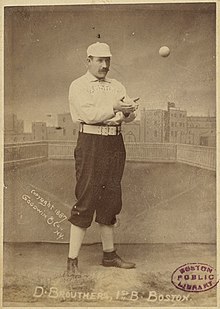Dan Brouthers
| Dan Brouthers | |
|---|---|
 | |
| First baseman | |
| Born: May 8, 1858 Sylvan Lake, New York, U.S. | |
| Died: August 2, 1932 (aged 74) East Orange, New Jersey, U.S. | |
Batted: Left Threw: Left | |
| MLB debut | |
| June 23, 1879, for the Troy Trojans | |
| Last MLB appearance | |
| October 4, 1904, for the New York Giants | |
| MLB statistics | |
| Batting average | .342 |
| Hits | 2,296 |
| Home runs | 106 |
| Runs batted in | 1,296 |
| Teams | |
| |
| Career highlights and awards | |
| |
| Member of the National | |
| Induction | 1945 |
| Election method | Old-Timers Committee |
Dennis Joseph "Dan" Brouthers (/ˈbruːθərz/;[1] May 8, 1858 – August 2, 1932) was an American first baseman in Major League Baseball whose career spanned the period from 1879 to 1896, with a brief return in 1904. Nicknamed "Big Dan" for his size, he was 6 feet 2 inches (1.88 m) and weighed 207 pounds (94 kg), which was large by 19th-century standards.[2]
Recognized as the first great slugger in baseball history,[3] and among the greatest sluggers of his era, he held the record for career home runs from 1887 to 1889,[4] with his final total of 106 tying for the fourth most of the 19th century. His career slugging percentage of .519 remained the Major League record for a player with at least 4,000 at bats until Ty Cobb edged ahead of him in 1922. At the time of his initial retirement, he also ranked second in career triples (205), and third in runs batted in (1,296) and hits.[5]
A dominant hitter during the prime of his career, he led (or was in the top of) the league in most offensive categories, including batting average, runs scored, runs batted in (RBI), on-base percentage and hits. He led the league in batting average five times, the most by a 19th-century player, and his career .342 batting average still ranks ninth all-time. Brouthers is one of only 29 players in baseball history to date who have appeared in Major League games in four decades.
He was also an active players' union member, and was elected vice president of the Brotherhood of Professional Base Ball Players. Brouthers was elected to the
Early life
Brouthers was born in
Brouthers played organized baseball beginning in childhood, from playing in the local sandlots
Major League career
Troy
Brouthers made his Major League debut on June 23,
After his release, Brouthers played for a
Buffalo
Brouthers got his first chance to be an everyday player in
Detroit and The Brotherhood

At the end of the
The Detroit team was filled with stars from the era, including future Hall of Famers
During the off-season, on November 11, 1886, The Executive Council of the Brotherhood of Professional Base Ball Players‚ formed in 1885 as the first organized players' union, met and re-elected John Montgomery Ward as president, and elected Brouthers as vice president.[9]
In
Following the season, on November 17, 1887, members of the NL officially recognized the Brotherhood and met with a Brotherhood committee that consisted of three players – Ward‚ Hanlon and Brouthers.[9]
The
Boston

In 1889, his only season with the Beaneaters, he batted a league-leading .373, along with 105 runs scored and 118 runs batted in; he struck out only six times.[10] The first strikeout occurred on June 11 against Mickey Welch of the Giants.[9]
After the season, he – along with many Major League players – jumped to the
The Players' League lasted just the one season, and the Reds merged into the American Association, carrying many of the championship team's previous players.[21] Again, the team won the league's championship, finishing 8+1⁄2 games ahead of the St. Louis Browns.[22] Brouthers led the league in batting average (.350), on-base percentage and slugging, while finishing second in triples with 19, sixth in doubles with 26, and third in RBIs with 109.[10]
Later career

After the American Association folded following the
This trade brought in two future Hall of Fame players, which added to the already established Orioles core of players including third baseman John McGraw, catcher Wilbert Robinson, shortstop Hughie Jennings, and center fielder Joe Kelley, all future Hall of Fame members.[23] The Orioles won the league's championship that season, and it was Brouthers' last full season in the majors, as he again produced great numbers, batting .347, finishing seventh in total bases, fifth in RBIs (128), fourth in doubles (39), and fifth in triples (23).[10]
During his career, and most notably during his time in Baltimore, he was known to always have his dog, an
Early in the
Brouthers is still among the all-time leaders in many offensive categories. His .342 batting average ranks ninth, 205 triples ranks eighth, and his .423 on-base percentage ranks 15th.[10] He is tied with Mike Tiernan for fourth among 19th-century home run hitters with a total of 106, behind Roger Connor (138), Sam Thompson (127), and Stovey (122).[25]
Later life and legacy

Brouthers played
He remained near baseball for many years, working for his former teammate and New York Giants manager John McGraw, who placed him in charge of the Polo Grounds press gate.[2] He was with the Giants for nearly 20 years in this and other capacities.[8]
On New Year's Eve in 1884, Brouthers married Mary Ellen Croak, an Irish immigrant to New York and fellow Catholic, at St. Mary's in Wappingers Falls. They had four children together and were married for 48 years until his death.[7]
Brouthers died at the age of 74 at his home in East Orange, New Jersey, and is interred at St. Mary's Church Cemetery in Wappingers Falls, New York.[8][6] There is a statue dedicated to him located in Veteran's Park in this small village.[26] In 1945, Brouthers and several other stars of the era prior to 1910 were elected to the Baseball Hall of Fame by the Veterans Committee.[2][3] In honor of his achievements in Buffalo, he was inducted into the newly formed Buffalo Baseball Hall of Fame in 1985.[27] In 1999, a survey of the Society for American Baseball Research ranked him as the sixth-greatest player of the 19th century.[28]
See also
- List of Major League Baseball career hits leaders
- List of Major League Baseball career doubles leaders
- List of Major League Baseball career triples leaders
- List of Major League Baseball career runs scored leaders
- List of Major League Baseball career runs batted in leaders
- List of Major League Baseball batting champions
- List of Major League Baseball annual doubles leaders
- List of Major League Baseball annual triples leaders
- List of Major League Baseball annual home run leaders
- List of Major League Baseball annual runs scored leaders
- List of Major League Baseball annual runs batted in leaders
- List of Major League Baseball players who played in four decades
- List of Major League Baseball single-game hits leaders
- List of Major League Baseball doubles records
- List of Major League Baseball triples records
- Major League Baseball titles leaders
References
- ISBN 0-7432-2722-0.
- ^ a b c d "The Ballplayers: Dan Brouthers". baseballbiography.com. Retrieved 2008-06-15.
- ^ a b "The National Baseball Hall of Fame: Dan Brouthers". baseballhalloffame.org. Archived from the original on January 12, 2008. Retrieved 2008-06-19.
- ^ "Progressive Leaders & Records for Home Runs". baseball-reference.com. Retrieved 2008-06-19.
- ^ Brouthers is credited with differing totals in career hits; at the time, he was credited with 2,349 hits, a figure still recognized by Major League Baseball, but this total includes 71 walks in 1887, when walks were counted as hits. There are slight variations in other seasons as well, but most sources today credit Brouthers with 2,296 hits.
- ^ a b c d "Dan Brouthers Stats". retrosheet.org. Retrieved 2008-06-15.
- ^ ISBN 9780786475605. Retrieved 5 July 2018.
- ^ a b c d "Dan Brouthers' obituary". The New York Times, August 3, 1932. Archived from the original on September 29, 2007. Retrieved 2008-06-15.
- ^ a b c d e f g h i j k l m "Dan Brouthers career chronology". baseballbiography.com. Retrieved 2008-06-15.
- ^ a b c d e f g h i j k l m n o p q "Dan Brouthers career stats". baseball-reference.com. Retrieved 2008-06-15.
- ^ "1886 Detroit Wolverines season stats". baseball-reference.com. Retrieved 2008-06-15.
- ^ "1886 National League Standings". baseball-reference.com. Retrieved 2008-06-15.
- ^ "1887 Detroit Wolverines season stats". baseball-reference.com. Retrieved 2008-06-15.
- ^ a b "Detroit Wolverines/1887 World Series". michigan.gov. Archived from the original on March 11, 2008. Retrieved 2008-06-15.
- ^ "1887 National League Standings". baseball-reference.com. Retrieved 2008-06-15.
- ^ "1887 World Series stats". baseball-reference.com. Retrieved 2008-06-15.
- ^ "1888 National League Standings". baseball-reference.com. Retrieved 2008-06-15.
- ^ "A Structure To Last Forever":The Players' League And The Brotherhood War of 1890". by Ethan M. Lewis. Retrieved 2008-06-15.
- ^ "1890 Boston Reds season stats". baseball-reference.com. Retrieved 2008-06-15.
- ^ "1890 Players' League Standings". baseball-reference.com. Archived from the original on 2009-02-16. Retrieved 2008-06-15.
- ^ "1891 Boston Reds season stats". baseball-reference.com. Retrieved 2008-06-15.
- ^ "1891 American Association Standings". baseball-reference.com. Retrieved 2008-06-15.
- ^ "1894 Baltimore Orioles season stats". baseball-reference.com. Retrieved 2008-06-15.
- ISBN 0-7432-2722-0.
- ^ "19th Century Baseball History". geocities.com. Archived from the original on 2009-10-20. Retrieved 2008-06-15.
- ^ "Dan Brouthers' Monument". www.ballparkreviews.com. Retrieved 2008-06-15.
- ^ "Buffalo Baseball Hall of Fame". Retrieved 29 August 2012.
- ^ "SABR Century Survey Results". The SABR Bulletin. 29 (7). Cleveland: Society for American Baseball Research: 8–9. July–August 1999.
External links
- Dan Brouthers at the Baseball Hall of Fame
- Career statistics and player information from MLB, or Baseball Reference, or Fangraphs, or Baseball Reference (Minors), or Retrosheet
